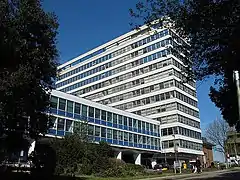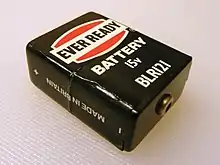British Ever Ready Electrical Company
The British Ever Ready Electrical Company (BEREC) was a British electrical firm formed in 1906 as the export branch of the American Eveready Battery Company. In 1914 it became independent of its American parent company.

For decades the firm dominated the UK consumer battery market and had several factories in the UK, the largest of which was built at Tanfield Lea, County Durham, in 1968. Other factories included Dawley, Four Ashes, Maldon, Newburn, London (Victoria Works and Forest Road) and Park Lane, Wolverhampton. The company's research effort was centred upon the Central Laboratories, later known as Group Technical Centre, in St. Ann's Road, Harringay, London N15. The company's head office was Ever Ready House in Whetstone, London N20.[1] Overseas manufacturing sites included South Africa, Nigeria, Sri Lanka and Jamaica. The company also included UK engineering divisions: Cramic Engineering and Toolrite.
In 1972, the company acquired J. A. Crabtree & Co, a manufacturer of electrical accessories.[2]
The company was the subject of a hostile takeover by Hanson Trust in 1981. Hanson closed factories, cut jobs and sold the German (Daimon) and Italian (Superpila) subsidiaries to Duracell.[3] Shortly before this the British Ever Ready Electrical Company changed its name to Berec Group. From the 1950s the BEREC name was only used for exports of batteries and radio sets (as British Ever Ready Export Company). Some Daimon batteries were branded BEREC as were some produced in Switzerland. One of Hanson's first decisions was to revert from BEREC to Ever Ready as the UK brand.

In 1992, the company was sold by Hanson Trust to Ralston Purina, owners of the American Eveready company, and is now a part of Energizer Holdings.[3] The company closed Tanfield Lea, its last UK factory, in 1996.[4] Production of some Ever Ready batteries (PP6, PP7 and PP9) continued in the UK until 1999 by Univercell Battery Company, located close to the old Dawley factory using the original machinery.
The company was also a producer of torches and bicycle lamps. Ever Ready also manufactured radios from 1934 up until 1964. Ever Ready owned a controlling interest in Lissen (radio sets mostly) from 1928. With the 1922 founder of Lissen forming Vidor in 1934, Ever Ready took over Lissen completely. Many models of radio set were manufactured in both Lissen and Ever Ready versions until 1941 when the Blitz ended production. From 1942 until 1945 only one Ever Ready radio model was produced. In 1981 three "offshore" models were produced, one from Hong Kong and two from Malaysia.[5] The "Saucepan Special" radio was sold in large numbers to Africa.[6] The Dawley factory was originally set up primarily to make B103 and B136 batteries for the Saucepan radio.
References
- "Archived copy" (PDF). Archived from the original (PDF) on 2007-10-25. Retrieved 2010-07-21.CS1 maint: archived copy as title (link)
- "Number one for news, opinion, sport & celebrity gossip". Birmingham Post. Retrieved 2013-09-30.
- David Bowen. "Assault and battery: The fall of the Ever Ready empire: a classic tale of British decline by David Bowen". The Independent. Retrieved 2016-12-18.
- "Ever Ready Factory, Tanfield Lea (Hansard, 21 February 1996)". Hansard.millbanksystems.com. 1996-02-21. Retrieved 2013-09-30.
- "To the new website". Localhistory.scit.wlv.ac.uk. Archived from the original on 2002-03-11. Retrieved 2013-09-30.
- 12.08.2014, Birkner †. "Saucepan Special J SW only Radio Ever Ready Co. GB Ltd.; Lon". www.radiomuseum.org. Retrieved 2018-04-09.CS1 maint: numeric names: authors list (link)
External links
- 1974 U.K. government document concerning Ever Ready/B.E.R.E.C., P. R. Mallory and Co Inc, Exide, Crompton Parkinson Ltd and Rayovac over an apparent monopoly by Ever Ready/B.E.R.E.C., Exide and P. R. Mallory and Co Inc at the other firms' apparent expense.
- Ever Ready Co. - company timeline, retrieved August 8, 2011